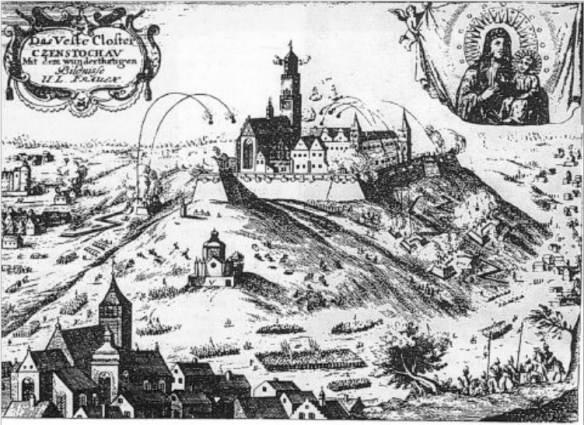The defence of the Pauline monastery of Jasna Góra against the Swedes, in November–December 1655. The engraving commemorates the miraculous intervention by the Blessed Virgin Mary to protect the monastery, which housed an icon of the Black Madonna, supposed to have been painted by St Luke the Evangelist (the icon dates from the fifteenth century). The failure of the siege marked a turning-point in the Swedish invasion, helping bring about a massive nationwide uprising, uniting all social classes against the invaders. In fact, of the comparatively small besieging force, only some 450 were Swedes. Most – around 1,000 – consisted of Polish troops who had defected in the early stages of Charles X’s invasion. This has done nothing to detract from the potency of the legend, which has helped to make the monastery the most celebrated religious site in Poland.
After the Thirty Years’ War ended in 1648, tensions remained high between Catholics and Protestants in Eastern Europe. The 1655-60 Second Northern War was one of the major aftershocks, pitting King Charles X Gustav’s Protestant Sweden against the Polish-Lithuanian Commonwealth under King John II Casimir Vasa. Poland was supported by the Haps- burg monarchy, and while the duchy of Brandenburg-Prussia initially supported Poland, it switched sides twice during the war. By war’s end Prussia had become a sovereign state.
In 1655 the commonwealth was already at war with Russia on its eastern border when Sweden invaded from the west. Lithuania almost immediately broke away from Poland and allied with Sweden. The mixed Swedish and German mercenary forces of Charles X then swept through and occupied what was left of Poland and forced John II into exile in Hapsburg Silesia. Poles refer to the Swedish invasion and occupation as the Deluge.
By late November 1655 the monastery at Czçestochowa was the only fortified position in Poland that had not been captured. Charles X sent a mixed force of 2,250 Swedes and Germans and 10 light cannon under General Burchard Müller von der Lühne to finish the job. Jasna Gora also housed a number of valuable ecclesiastical treasures the Pauline monks were loath to let fall into Protestant hands. As a precautionary measure they replaced the Black Ma- donna with a copy and moved the original to the monastery at Glogowek for safekeeping.
Led by Augustyn Kordecki, the prior of the monastery, some 70 monks prepared to defend Jasna Gora. Kordecki had purchased 60 muskets and an extensive quantity of ammunition and hired 160 professional soldiers. Joining them were about 80 volunteers, mostly members of the szlachta, or Polish nobility. Mounted on the defensive walls were some 18 light cannon and a dozen heavier 12-pounders. Thus at the start of the siege while the attackers outnumbered the defenders 7-to-1, the Poles significantly outgunned the Swedes.
After several futile attempts to negotiate surrender, Müller began the siege on November 18. The superior Polish artillery held the attackers at bay, and on the 28th a nighttime sortie by the defenders destroyed two Swedish guns. At month’s end the Swedes received reinforcements of 600 men and three light guns. On December 10 more reinforcements arrived, including another 200 men, four 12-pounders and two 24-pounders. The Swedes now had proper siege artillery and a 10-to-1 advantage in men.
For a month the monastery withstood almost constant shelling. The Poles continually fired back, inflicting high casualties on the poorly entrenched Swedes. Additional Polish sorties killed more attackers and destroyed more guns, including one of the 24-pounders. The other 24-pounder exploded in position when it malfunctioned. Running low on ammunition and rations and surrounded by a hostile countryside in the midst of winter, Müller finally withdrew on December 27. The Swedes and Germans had suffered several hundred casualties, the Poles only a few dozen. Jasna Gora had held out, and Polish morale soared. After his return from Silesia in January 1656, John II held an April 1 ceremony in the cathedral at Lwow, entrusting Poland to the protection of the Virgin Mary and proclaiming her the patron and perpetual queen of Poland. By 1660 the Poles had driven out the Swedes, mopping up the Deluge.
A century later Jasna Gora was subjected to another major siege, after a 1768 revolt by the Bar Confederation of the szlachta against the Russian-dominated Polish crown. During the revolt a group of nobles under Casimir Pulaski defended Jasna Gora against a 1770-71 siege by a much larger Russian force that ultimately prevailed. Pulaski managed to escape but was forced out of Poland. Several years later he turned up in Paris where U. S. ambassador Benjamin Franklin recruited him for the Continental Army as a brigadier general and America’s first cavalry commander. Pulaski was killed during the 1779 siege of Savannah.
The Deluge, an 1886 novel by Nobel Prize-winning Polish author Henryk Sienkiewicz, is a fictionalized account of the Second Northern War, its closing chapters devoted to the siege. Jasna Gora Monastery remains Poland’s most important pilgrimage site, as well as a major tourist attraction, with visitors numbering in the thousands on a typical day. The rebuilt defensive bastions appear much as they did in 1655, although no physical evidence of either the 1655 or 1770-71 sieges remain. For Poles Jasna Gora is hallowed ground twice over.
